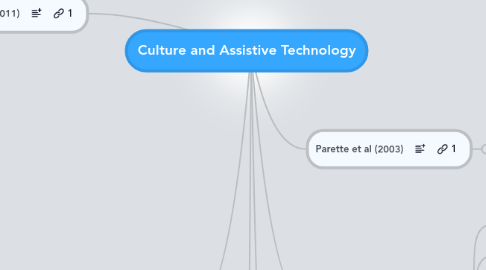
1. Boujarwah et al (2011)
1.1. Lifestyle
1.1.1. Family stucture
1.1.2. Linguistic environment
1.1.3. religion
1.2. Socio-technological infrastructure
1.2.1. Technology and civic infrastucture
1.2.2. Programs and services
1.3. monetary and informational resources
1.3.1. monetary concerns
1.3.2. Informational resources
2. Krefting, Krefting (1991)
2.1. Cultural factors that affect assistive technology delivery:
2.1.1. 1 Use of term
2.1.2. 2 Balance of work and play
2.1.3. 3 Sense of personal space
2.1.4. 4 Values regarding finance
2.1.5. 5 Role assumed in the family
2.1.6. 6 Knowledge of disabilities and source of information
2.1.7. 7 Beliefs about causality
2.1.8. 8 View of the inner working of the body
2.1.9. 9 Sources of social support
2.1.10. 10 Acceptable amount of assistance from others
2.1.11. 11 Degree of importance attributed to physical appearance
2.1.12. 12 Degree of importance attributed to independence
2.1.13. 13 Sense of control over thing that happen
2.1.14. 14 Typical or preferred coping strategies
2.1.15. 15 Style of expressing emotions
3. Ripat and Woodgate (2011)
3.1. Stigmatisation due to type of AT advised
3.2. AT suitability for the environment in which it will be used.
3.3. Appropriateness of language used (AAC)
3.4. Disability as a culture
3.5. AT services in diverse populations
4. Nathalie Nahai
4.1. Gender
4.2. Colour
4.3. Symbols
4.4. Language
4.5. Body Positions
4.6. Social Contexts
4.7. Aesthetics
5. Parette et al (2003)
5.1. View of disability and therefore support AT can offer
5.2. Independence v dependence
5.3. amount of information convey may depend on language
5.4. nonverbal communication cues
5.5. Direct and indirect questioning
6. Hofstede, G.
6.1. National Cultural Dimensions
6.1.1. Power Distance (PDI)
6.1.2. Individualism versus collectivism (IDV)
6.1.3. Masculinity versus femininity (MAS)
6.1.4. Uncertainty avoidance (UAI)
6.1.5. Long-term versus short-term orientation (LTO)
6.1.6. Indulgence versus Restraint (IVR)
